Amsterdamse Cavaleriekazerne
Built in 1864 as a neoclassical cavalry barracks, designed by the Ministry of War, the complex originally housed cavalry, horses, and equipment and was part of the defensive system around Amsterdam. The barracks were used by the Wehrmacht during the German occupation period. The Dutch army took over the barracks after the war and left permanently in 1988. The complex became a national monument in 2001.
There is also a commemorative plaque here marking the Amsterdam Revolution. Four people were killed and several injured on 13 November 1918 when soldiers opened fire on demonstrators who were trying to gain access to the Cavalry Barracks on Sarphatistraat in Amsterdam. After a turbulent meeting in the Diamond Exchange on Weesperplein, a crowd of an estimated three thousand people had made their way to the barracks in the hope that the soldiers stationed there and in the neighbouring Oranje Nassau Barracks would join the proletarian revolution, as soldiers in Russia and Germany had done earlier.
Do you have more information about this location? Inform us!
Source
- Text: TracesofWar
- Photos: Rick Hoogervorst
Nearby
Museum
- Memorial Centre Hollandsche Schouwburg Amsterdam - Amsterdam
- National Holocaustmuseum - Amsterdam
- Resistance-museum Amsterdam - Amsterdam
Point of interest
- Stelling van Amsterdam - National Warehouse of Medicines - Amsterdam
- Metis Montessori Lyceum - Amsterdam
- Stelling van Amsterdam - General Military Hostel - Amsterdam
Monument
- Memorial "43 Children" Amsterdam - Amsterdam
- Memorial Plates Henriëtte Pimentel Bridge - Amsterdam
- Memorial 'Liro' - Amsterdam
Cemetery
- De Nieuwe Kerk - Amsterdam
- Dutch War Graves New Eastern Cemetery Amsterdam - Amsterdam
- Polish War Graves New Eastern Cemetery Amsterdam - Amsterdam
Remembrance Stone
- Stumbling Stones Plantage Muidergracht 131b - Amsterdam
- Stumbling Stones Plantage Badlaan 24 - Amsterdam
- Stumbling Stones Plantage Badlaan 15 l - Amsterdam
Fortification
- Stelling van Amsterdam - Willem III-sluis - Amsterdam
- Stelling van Amsterdam - Willem I-sluis - Amsterdam
- Marinevliegkamp Schellingwoude (Seefliegerhorst Schellingwoude) - Shelter - Amsterdam






